Five hundred meter Aperture Spherical Telescope
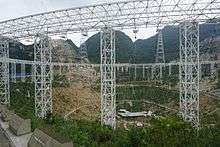 Under construction in 2015. Final form is a metallic dish. | |
| Location(s) | Pingtang County, People's Republic of China |
|---|---|
| Coordinates | 25°39′10.5″N 106°51′23.7″E / 25.652917°N 106.856583°E[1]Coordinates: 25°39′10.5″N 106°51′23.7″E / 25.652917°N 106.856583°E[2] |
| Wavelength | 10 cm to 4.3 m[3]:11[4] |
| Built | 2011–July 3, 2016 |
| First light | 25 September 2016 |
| Telescope style | Deformable fixed primary |
| Diameter |
500 m (physical) 300 m (effective)[3]:12 |
| Collecting area | 196,000 m2 (2,110,000 sq ft) |
| Focal length | 140 m (f/0.466)[3]:12 |
| Website |
fast |
|
|
| Wikinews has related news: Final panel added to China's FAST radio telescope |
| Five hundred meter Aperture Spherical Telescope | |||||||
| Traditional Chinese | 500米口徑球面射電望遠鏡 | ||||||
|---|---|---|---|---|---|---|---|
| Simplified Chinese | 500米口径球面射电望远镜 | ||||||
| |||||||
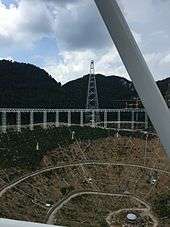
The Five-hundred-meter Aperture Spherical radio Telescope (FAST; Chinese: 五百米口径球面射电望远镜), nicknamed Tianyan (天眼, lit. "Heavenly Eye" or "The Eye of Heaven"), is a radio telescope located in the Dawodang depression (大窝凼洼地), a natural basin in Pingtang County, Guizhou Province, southwest China.[5] It consists of a fixed 500 m (1,600 ft) dish constructed in a natural depression in the landscape. It is the world's largest filled-aperture radio telescope,[6] and the second-largest single-dish aperture after the sparsely-filled RATAN-600 in Russia.[3][7]
It has a novel design, using an active surface for pointing and focusing, rather than only correcting residual errors,[8] and suspending the receiver on a computer-controlled winch system without any rigid connection to the primary.
Construction on the FAST project began in 2011 and it achieved first light in September 2016. It is currently undergoing testing and commissioning.
History
The telescope was first proposed in 1994. The project was approved by the National Development and Reform Commission (NDRC) in July 2007.[9][8] A 65-person village was relocated from the valley to make room for the telescope[10] and an additional 9,110 people living within a 5 km radius of the telescope were relocated to create a radio-quiet area.[10][11] About 500 families tried to sue the local government.[12]
On 26 December 2008, a foundation laying ceremony was held on the construction site.[13] Construction started in March 2011,[14][15] and the last panel was installed on the morning of 3 July 2016.[10][15][16][17]
Originally budgeted for CN¥700 million,[3]:49[14] the final cost was CN¥1.2 billion (US$180 million).[10] Significant difficulties encountered were the site's remote location and poor road access, and the need to add shielding to suppress radio-frequency interference from the primary mirror actuators.[8] There are still ongoing problems with the failure rate of the primary mirror actuators.[8]
Testing and commissioning began with first light on 25 September 2016.[18] The first observations are being done without the active primary reflector, configuring it in a fixed shape and using the Earth's rotation to scan the sky.[8] Subsequent early science will take place at lower frequencies[19] while the active surface is brought to its design accuracy;[20] longer wavelengths are less sensitive to errors in reflector shape. It will take three years to calibrate the various instruments so it can become fully operational.[18] Once it does, it will likely require hundreds of astronomers. However, due to the shortage of astronomers, the telescope will not operate at full capacity for a long time.[21]
Local government efforts to develop a tourist industry around the telescope are causing some concern among astronomers worried about nearby mobile telephones.[22]
The primary driving force behind the project[8] is Nan Rendong (南仁东), a researcher with the Chinese National Astronomical Observatory, part of the Chinese Academy of Sciences. He holds the positions of chief scientist[17] and chief engineer[8] of the project.
Overview
FAST has a fixed primary reflector located in a natural hollow in the landscape (karst), focusing radio waves on a receiver suspended 140 m (460 ft) above it. The reflector is made of perforated aluminium panels supported by a mesh of steel cables hanging from the rim.
FAST's surface is made of 4450[10] triangular panels, 11 m (36 ft) on a side,[23] in the form of a geodesic dome. 2225 winches located underneath[8] make it an active surface, pulling on joints between panels, deforming the flexible steel cable support into a parabolic antenna aligned with the desired sky direction.[24]
Above the reflector is a light-weight feed cabin moved by a cable robot using winch servomechanisms on six support towers.[15]:13 The receiving antennas are mounted below this on a Stewart platform which provides fine position control and compensates for disturbances like wind motion.[15]:13 This produces a planned pointing precision of 8 arcseconds.[3]:24[9]:179
FAST is capable of pointing anywhere within ±40° from the zenith.[15]:4 The effective aperture is reduced by vignetting at angles above ±30°.[3]:13
Although the reflector diameter is 500 metres (1,600 ft), only a circle of 300 m diameter is used (held in the correct parabolic shape and "illuminated" by the receiver) at any one time.[15]:3 Thus, the name is a misnomer: the aperture is not 500 m, nor is it spherical.
Its working frequency range of 70 MHz to 3.0 GHz,[25] with the upper limit set by the precision with which the primary can approximate a parabola. It could be improved slightly, but the size of the triangular segments limits the shortest wavelength which can be received. This range is covered by 9 receivers on the feed cabin,[3]:30 with the 1.23–1.53 GHz band around the hydrogen line using a 19-beam receiver built by the CSIRO as part of the ACAMAR[26] collaboration between the Australian Academy of Science and the Chinese Academy of Sciences.[27]
The Next Generation Archive System (NGAS), developed by the International Center for Radio Astronomy (ICRAR) in Perth, Australia and the European Southern Observatory will store and maintain the large amount of data that it collects. [28]
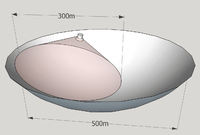 300 m illuminated aperture within 500 m dish
300 m illuminated aperture within 500 m dish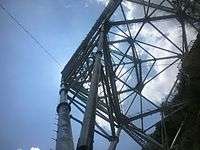 One of six support towers
One of six support towers
Comparison with Arecibo observatory
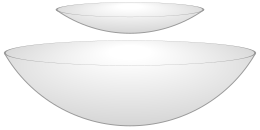
The basic design of FAST is similar to the Arecibo Observatory radio telescope. Both are fixed primary reflectors installed in natural hollows, made of perforated aluminum panels with a movable receiver suspended above. There are, however, four significant differences in addition to the size.[24][29][30]
First, Arecibo's dish is fixed in a spherical shape. Although it is also suspended from steel cables with supports underneath for fine-tuning the shape, they are manually operated and adjusted only for maintenance.[24] It has a fixed spherical shape and two additional reflectors suspended above to correct for the resultant spherical aberration.[31]
Second, Arecibo's receiver platform is fixed in place. To support the greater weight of the additional reflectors, the primary support cables are static, with the only motorised portion being three hold-down winches which compensate for thermal expansion.[24]:3 The antennas are mounted on a rotating arm below the platform.[24]:4 This smaller range of motion limits it to viewing objects within 19.7° of the zenith.[32]
Third, the FAST dish is significantly deeper, contributing to a wider field of view. Although 64% larger in diameter, FAST's radius of curvature is 300 m (980 ft),[15]:3 barely larger than Arecibo's 270 m (870 ft),[32] so it forms a 113° arc[15]:4 (vs. 70° for Arecibo). Although Arecibo's full aperture of 305 m (1,000 ft) can be used when observing objects at the zenith, the effective aperture for more typical inclined observations is 221 m (725 ft).[24]:4
Fourth, Arecibo's larger secondary platform also houses several transmitters, making it one of only two instruments in the world capable of radar astronomy. The NASA-funded Planetary Radar System allows Arecibo to study solid objects from Mercury to Saturn, and to perform very accurate orbit determination on near-earth objects, particularly potentially hazardous objects. Arecibo also includes several NSF funded radars for ionospheric studies. These powerful transmitters are too large and heavy for FAST's small receiver cabin, so it will not be able to participate in planetary defense.
The Arecibo observatory has the advantage of location closer to the equator, so the Earth's rotation scans a larger fraction of the sky. Arecibo is located at 18.35° N latitude, while FAST is sited about 7.5° farther north, at about 25.80° N. FAST's wider field of view more than makes up for this.
See also
- Chinese space program
- Square Kilometre Array, a proposed 1 km2 telescope array in Australia and South Africa
- KARST, a 1990s Chinese proposal to host the SKA
References
- ↑ Location taken from satellite views. Project documents give the location as 25°38′50″N 106°51′21″E / 25.64722°N 106.85583°E, but that appears to be inaccurate by about 500 m to the south.
- ↑ Location taken from satellite views. Project documents give the location as 25°38′50″N 106°51′21″E / 25.64722°N 106.85583°E, but that appears to be inaccurate by about 500 m to the south.
- 1 2 3 4 5 6 7 8 Nan, Rendong (April 2008). Project FAST — Five hundred meter Aperture Spherical radio Telescope (PDF). China-US Bilateral Workshop on Astronomy. Beijing. Retrieved 4 July 2016.
- ↑ Harris, Margaret (27 January 2009). "China builds super-sized radio telescope - physicsworld.com". physicsworld.com. Retrieved 20 October 2015.
- ↑ "中国"天眼"能不能发现外星人?" [Can Chinese Tianyan find aliens?] (in Chinese). XINHUANET.com. 22 February 2016.
- ↑ Brinks, Elias (11 July 2016). "China Opens the Aperture to the Cosmos". The Conversation. US News and World Report. Retrieved 12 August 2016.
- ↑ "China starts building world's biggest radio telescope". New Scientist. 8 June 2011. Retrieved 19 October 2015.
- 1 2 3 4 5 6 7 8 Normile, Dennis (26 September 2016). "World's largest radio telescope will search for dark matter, listen for aliens". Science News. doi:10.1126/science.aah7346.
- 1 2 Jin, C. J.; Nan, R. D.; Gan, H. Q. (2007). "The FAST telescope and its possible contribution to high precision astrometry" (PDF). International Astronomical Union. 248: 178–181. doi:10.1017/S1743921308018978. Retrieved 19 October 2015.
- 1 2 3 4 5 "Xinhua Insight: Installation complete on world's largest radio telescope". Xinhua. 3 July 2016.
- ↑ Wong, Edward (17 February 2016). "China Telescope to Displace 9,000 Villagers in Hunt for Extraterrestrials". New York Times.
The report said officials were moving 2,029 families, a total of 9,110 people, who live within about three miles of the telescope in the area of Pingtang and Luodian Counties in the southwestern province of Guizhou. Depopulating the area will create "a sound electromagnetic wave environment" for the telescope, Xinhua said.
- ↑ "'Thank the aliens': Thousands displaced for China's huge telescope". AFP. 2016-12-01. Retrieved 2016-12-01.
- ↑ "中国科学院·贵州省共建国家重大科技基础设施500米口径球面射电望远镜(FAST)项目奠基" (in Chinese). Guizhou Daily. 27 December 2008. Retrieved 28 December 2008.
- 1 2 Quick, Darren (16 June 2011). "China building world's biggest radio telescope". gizmag. Retrieved 13 August 2012.
- 1 2 3 4 5 6 7 8 Rendong Nan; Di Li; Chengjin Jin; Qiming Wang; Lichun Zhu; Wenbai Zhu; Haiyan Zhang; Youling Yue; Lei Qian (20 May 2011). "The Five-Hundred-Meter Aperture Spherical Radio Telescope (FAST) Project". International Journal of Modern Physics D. 20 (6): 989–1024. arXiv:1105.3794
 . doi:10.1142/S0218271811019335.
. doi:10.1142/S0218271811019335. - ↑ "China completes installation of world's largest telescope". The BRICS Post. 3 July 2016.
- 1 2 McKirdy, Euan (12 October 2015). "China looks to the stars with creation of world's largest radio telescope". CNN News. Retrieved 19 October 2015.
- 1 2 Morelle, Rebecca (25 September 2016). "China's colossal radio telescope begins testing". BBC News. Retrieved 25 September 2016.
- ↑ Yue, Youling; Li, Di; Nan, Rendong (20–31 August 2012). FAST low frequency pulsar survey. Neutron Stars and Pulsars: Challenges and Opportunities after 80 years. arXiv:1211.0748
 . doi:10.1017/S174392131300001X.
. doi:10.1017/S174392131300001X. - ↑ Li, Di; Nan, Rendong; Pan, Zhichen (20–31 August 2012). The Five-hundred-meter Aperture Spherical Radio Telescope Project and its Early Science Opportunities. Neutron Stars and Pulsars: Challenges and Opportunities after 80 years. arXiv:1210.5785
 . doi:10.1017/S1743921312024015. Video available at http://www.pulsarastronomy.net/IAUS291/video/DiLi/
. doi:10.1017/S1743921312024015. Video available at http://www.pulsarastronomy.net/IAUS291/video/DiLi/ - ↑ "院士:建世界最大射电望远镜不是为了发展旅游". Caixin Online (in Chinese). 25 September 2016.The English-language version of the article at http://english.caixin.com/2016-09-26/100992047.html does not mention this issue,which is only mentioned on the much longer and detailed Chinese version here.
- ↑ Chen, Zhou; Gang, Wu. "Scientists Concerned About Plans to Make Telescope a Tourist Attraction". Caixin Online. Retrieved 26 September 2016.
- ↑ "China assembles world's largest telescope in Guizhou". Xinhua. 24 July 2015 – via China.org.cn.
- 1 2 3 4 5 6 Williams, R.L. II (July 2015). Five-Hundred Meter Aperture Spherical Radio Telescope (FAST) Cable-Suspended Robot Model and Comparison with the Arecibo Observatory (PDF) (Report). Ohio University.
- ↑ "Receiver Systems". FAST Home Page. National Astronomical Observatories, Chinese Academy of Sciences. Retrieved 28 June 2014.
- ↑ "Australia-ChinA ConsortiuM for Astrophysical Research (ACAMAR)". CAASTRO: ARC Centre of Excellence for All-sky Astrophysics. Archived from the original on 2016-05-07. Retrieved 1 October 2016.
- ↑ Strom, Marcus (6 May 2016). "CSIRO technology to be at the heart of the world's largest radio telescope in China". Sydney Morning Herald. Fairfax Media. Retrieved 7 May 2016.
- ↑ "FAST Radio Telescope Open for Business - Sky & Telescope". Sky & Telescope. 2016-09-27. Retrieved 2016-10-10.
- ↑ Jin, Chengjin; Zhu, Kai; Fan, Jin; Liu, Hongfei; Zhu, Yan; Gan, Hengqian; Yu, Jinglong; Gao, Zhisheng; Cao, Yang; Wu, Yang (23 October 2013). The optics of the Five-hundred-meter Aperture Spherical radio Telescope (PDF). Internaltional Symposium on Antennas and Propagation. Nanjing: National Astronomical Observatories, Chinese Academy of Sciences.
- ↑ Qiu, Yuhai H. (11 December 1998). "A novel design for a giant Arecibo-type spherical radio telescope with an active main reflector" (PDF). Monthly Notices of the Royal Astronomical Society. Beijing Astronomical Observatory, The Chinese Academy of Sciences. 301 (3): 827–830. doi:10.1111/j.1365-8711.1998.02067.x.
- ↑ Cortés-Medellín, Germán (13 September 2010). AOPAF: Arecibo Observatory Phased Array Feed (PDF) (Report). National Astronomy and Ionosphere Center, Cornell University.
- 1 2 "Arecibo: General Statistical Information on Antenna". National Astronomy and Ionospheric Center. 3 January 2005. Retrieved 5 July 2016.
Further reading
- Nan, R.; et al. (16 June 2002). "Kilometer-square Area Radio Synthesis Telescope – KARST" (PDF).
- Jin, C.; Nan, R. D.; Gan, H. Q. (2008). "The FAST telescope and its possible contribution to high precision astrometry." (PDF).
External links
- Five-hundred-meter Aperture Spherical radio Telescope - website
- Building the world's largest radio telescope – BBC News on YouTube